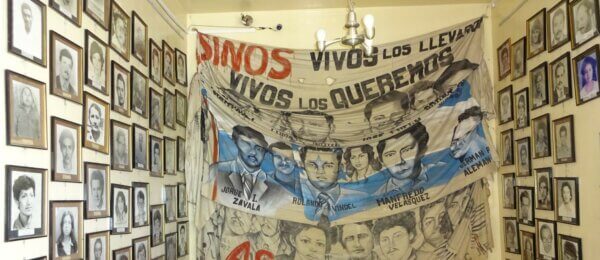
By Liza Yelle
Voluntary Legal Adviser
Honduras is sometimes forgotten when it comes to enforced disappearances, since the country was not as badly affected as other Latin American countries, such as its neighbors Guatemala and El Salvador. However, at least 184 people were victims of enforced disappearance during the implementation of the national security doctrine in the 1980s.
Although these atrocities occurred just over 30 years ago, Honduran youth have very little knowledge of this dark period in their history and are sometimes not at all aware of the existence of these crimes at that time.
The duty to preserve memory
The Comité de Familiares de Detenidos Desaparecidos en Honduras (COFADEH) was founded in 1982 by the relatives of victims of enforced disappearances in the 1980s and 1990s with the aim of tracing their family members and obtaining justice for these crimes.
Over the years, the organization’s mandate has gradually expanded to include advocacy and representation of victims of human rights violations, capacity building, and case research and documentation.
However, despite the shift towards a general human rights defense, the preservation of historical memory remains one of the organization’s priorities.
The Ruta de la Memoria Historica
To date, there has been little progress in the investigation of enforced disappearances and no convictions have taken place. The families of the victims are left in the dark and their wounds remain open, having no answer and not knowing the truth.
In order to preserve the history that is unfortunately little documented and to preserve the memory of the victims, COFADEH organizes the Ruta de la Memoria Histórica which revisits certain places related to enforced disappearances in Honduras. Last fall, a few weeks before the elections, I had the opportunity to accompany a group of students who were taking part in the Ruta.
We first walked downtown where members of the organization told us where they used to go to protest and call on the authorities to investigate and search for their loved ones in the 1980s and 1990s. They then took us to villages outside the city, where clandestine cemeteries were located, that is, where the bodies of some of the disappeared were found. As we listen to the stories of people who lived through these years of distress, the mere thought of the pain felt by the loved ones of the disappeared leaves us breathless.
Finally, we went to visit the Casa del Terror, an abandoned estate isolated in a field. It is assumed that a wealthy person was the owner. There is a small house for employees on the side and a damaged fountain in front of the house.
The atmosphere is extremely heavy, due to the testimonies of survivors and neighbors in the area who affirm that several people were executed in the house and others tortured.
Traces of bullets and chalk marks can be seen on the walls where the investigators found traces of blood. Investigations that always lead to nothing. The visit is heartbreaking. The stories of survivors who passed through this house are appalling and we know that there are probably other places like this that we do not know of.
To never give up
I like to think that things are changing, that more than 30 years later the country and the practices have changed. However, since the elections of November 26, 2017, the country has been in an electoral crisis and at least 38 people have been murdered, the majority by security forces, and one person has been the victim of enforced disappearance. It is difficult not to feel helpless in the face of this horrible situation.
All this work and so little change. Fortunately, citizens such as COFADEH members continue to believe and fight every day for what sometimes seems impossible.
About the author
Liza Yelle is a volunteer legal advisor in Honduras for the Protection of children, women and other vulnerable communities (PRODEF) project. This project, supported by Global Affairs Canada, is conducted in consortium with the International Bureau for Children’s Rights.

